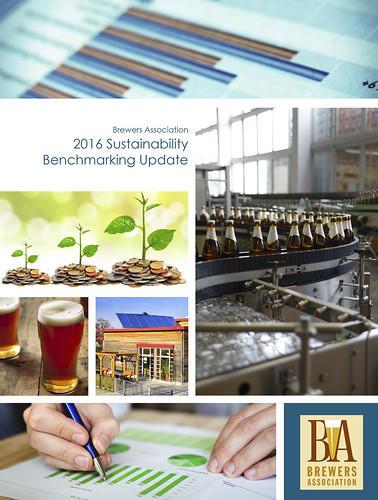In 2015, the [U.S.] Brewers Association (BA) published its first Sustainability Benchmarking Report. Based on data from 2014, the report highlighted best 'craft' brewery practices in utility usage and sustainability. Earlier this week, the BA released its newest Sustainability Benchmarking Update, based on data from 2016.
This document is an update to the inaugural report, and it highlights certain data from 2015. Electricity, natural gas, water, and purchased CO2 were evaluated based on a normalized scale per barrel (bbl) of beer packaged. [...] This update focuses on four environmental attributes as key performance indicators (KPIs): electricity, natural gas, water, and carbon dioxide. In some sections, wastewater costs and greenhouse gas emissions are also discussed. Although there are other KPIs highlighted in the 2015 Sustainability Benchmarking Report, and additional metrics can be entered on the dashboard, KPIs presented in this report capture the primary environmental and economic attributes of concern to the craft brewing industry. [...]—[U.S.] Brewers Association. 23 October 2017.
Best-in-class performance from the first two years of submitted data includes:Sustainability benchmarking and sharing of best practices is not a one-time project. The online benchmarking tools are intended to provide an ongoing platform that constantly refreshes and identifies new best practices through tracking of sustainability-related key performance indicators (KPIs). As benchmarking participation grows, the data will become more robust, and drivers behind those best-in-class performers will be identified and shared.
- 6.7 kWh electricity/bbl (ranged from 6.7-709)
- 0.84 therm natural gas/bbl (ranged from 0.84-37.6)
- 3.31 bbl water/bbl (ranged from 3.31-81.7)
- 0 lb CO2 purchased/bbl (ranged from 0-78)
[Appears to mean that a brewery was able to capture and scrub from fermentation any CO2 it needed for other points of operation, an expensive proposition beyond the means of all but larger breweries.]
It is encouraging to see the number of BA members that have recognized business value in continuing to input monthly data through 2016 and into 2017, setting and tracking progress against targets, and sharing best practices. The next benchmarking report will focus on trends and other insights from the analysis of data from 2014, 2015, and 2016. Data presented in this report supersedes [sic] previous studies and should be considered the most up-to-date.
A winemaker once told me that he wasn't interested in having his winery certified organic, but in it being sustainable. With many organic practices —best practices for his farm and winery— in the mix for himself and his neighbors, he was woring toward ensuring that his business would be sustained, that is, survive, and maybe thrive, for another year(s). In other words, sustainability is not simply tree-hugging morality but profit-making, good business. I'm sure many brewers would agree.
To accompany its report, the BA provides an online suite of Sustainability Benchmarking Tools to assist breweries in tracking monthly utility bills, identifying opportunities to save energy and money, and benchmarking per-barrel performance.
This is just one example of the great work that the [U.S.] Brewers Association can do for its 'craft' brewery members as opposed to some of the silly stuff it does do.
-----more-----
- Read more at the BA.
- Read the full report (pdf format).
- This story originally appeared on YFGF's Facebook page.
- A tip of YFGF's fedora to Lucy Saunders for tweeting about this story. Ms. Sanders, aka the BeerCook, is the author of many beer cookbooks, including her most recent, "Dinner in the Beer Garden," and is actively involved in advocacy for clean water for the Great Lakes, including its intrinsic importance to breweries.
- For more from YFGF:
- Follow on Twitter: @Cizauskas.
- Like on Facebook: YoursForGoodFermentables.
- Follow on Flickr: Cizauskas.
- Follow on Instagram: @tcizauskas.










No comments:
Post a Comment
Comment here ...